
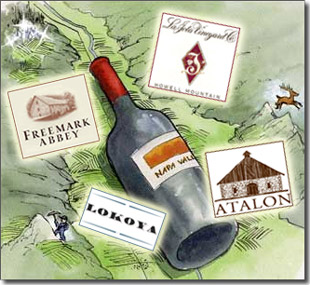
Kendall-Jackson continues to add to its already omnipresent vineyard and winery holdings
in Napa Valley.
Kendall Jackson’s Napa Valley
Holdings Are Impressive
...and so is its reliance on AVA designations for its wines.
by
Alan Goldfarb
March 14, 2007
Carpenter spoke with with me about his philosophy of winemaking as it pertains to the single AVA-designated wines which he produces.
Alan Goldfarb (AG): Why is Artisans & Estates focusing on AVAs and not necessarily on vineyard-designated wines?
Chris Carpenter (CC): I think there’s some value in the couple (sic) of the wineries that are out there doing them as single-vineyard designates. But it gets confusing to the consumer when you have 10 different vineyard-designated wines. It’s so much easier to have it as an AVA designation.
AG: Why is that easier?
CC: The level of detail that has to be asked of the consumer at the vineyard-designated level is much greater than at the AVA level. If the consumer has an understanding of what an AVA brings to the wine – body, flavor, and structure – they’ll have a fairly good understanding of what is in the middle. If you used every vineyard in the Napa Valley, that’s a lifetime of work. Many growers don’t even know that information.
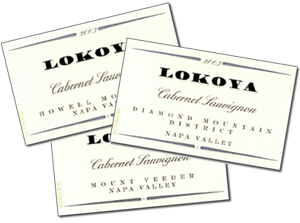
Lokoya’s Cabernet program highlights the different terroirs of Napa’s Mountain appellations.
The picking-call and fermentations are identical. The differences are between the vineyard and the AVA. And that is what we’re trying to do at Lokoya.
AG: You’re using Howell Mountain, Mount Veeder and Diamond Mountain as individual wines. What are the differences?
CC: There are some base flavors or appellation-specific flavors that you get out of those wines. They need to stand apart … and they need to be recognized as having characteristics that set them apart from one another.
(For instance), my style is very different from (Diamond Mountain winemakers) Dawnine Dyer (Dyer Vineyard) or Rudy von Strasser’s (von Strasser Winery). It’s like that “Iron Chef” thing – they’re each given the same raw product – say cod from the Grand Banks (of New England) – but they each have their individual characteristics.
AG: Are we going to see more producers going to AVA-designated wines?
CC: The folks at Ridge and at Rosenblum started this. Each winery has its own kind of mission and how it decides it wants to meet market demands. Lokoya has been a great success and it’s worked for us. I don’t know if others want to invest in the knowledge it takes.
AG: Save for a Merlot made by your colleague Tom Peffer at Atalon, all of the A&E wines are Cabernet Sauvignon-based. We now know, after 40 years, that Napa Valley primarily means Cabernet. But since you have several properties, what about product variation?
CC: Lokoya’s style is California Cabernet Sauvignon. Part of embracing an appellation is to do what it offers you. And that’s a ripe style. It’s something that France can’t achieve. Back in the ‘70s, we were making wines to emulate the French. Now, we don’t have to do that. Now, they’re more a reflection of California.
AG: What I’m getting at though, is sameness. There doesn’t seem to be much variation in Napa Valley Cabernets; and many seem to be big, showy wines. That’s why I applaud A&E for at least trying to do this by separating your wines along AVA lines.
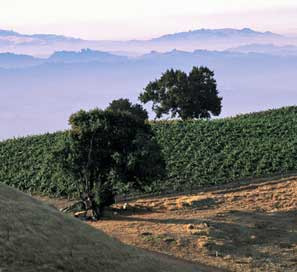
Cardinale Estate vineyards in Napa Valley's Oakville AVA.
CC: I want to make a California wine. And part of making a California wine is (to make) a reflection of the style that this area has to offer. Dialing back over-the-top winemaking is a good thing. Wines have to be balanced. That’s where the critics have to focus. … We all have something to offer and it’s a little bit different, and the consumer can have a choice. You might like redheads and I might like blondes. We don’t argue about it – it’s just a preference thing.
The key is always balance. That’s how you need to approach everything in this business. That’s when you start getting the hemming and hawing about the style. You can still achieve that big California style, but with balance. We’d be losing something if we all went back to wines we made in the ‘70s.
AG: I’m not advocating going back to making wines as were produced in the ‘70s, but something’s got to give. As you point out, balance is everything, but I contend that we’re seeing a lot of wine out there – albeit wines that the consumer seems to like – that are out of whack.
CC: The variety is Cabernet (here) but we haven’t gone to a specific style or a consumer plan. We always deal with the pressures that the critics put on us, but there’s enough integrity in the industry (to make balanced wines).
Alan Goldfarb (AG): Why is Artisans & Estates focusing on AVAs and not necessarily on vineyard-designated wines?
Chris Carpenter (CC): I think there’s some value in the couple (sic) of the wineries that are out there doing them as single-vineyard designates. But it gets confusing to the consumer when you have 10 different vineyard-designated wines. It’s so much easier to have it as an AVA designation.
AG: Why is that easier?
CC: The level of detail that has to be asked of the consumer at the vineyard-designated level is much greater than at the AVA level. If the consumer has an understanding of what an AVA brings to the wine – body, flavor, and structure – they’ll have a fairly good understanding of what is in the middle. If you used every vineyard in the Napa Valley, that’s a lifetime of work. Many growers don’t even know that information.

Lokoya’s Cabernet program highlights the different terroirs of Napa’s Mountain appellations.
The picking-call and fermentations are identical. The differences are between the vineyard and the AVA. And that is what we’re trying to do at Lokoya.
AG: You’re using Howell Mountain, Mount Veeder and Diamond Mountain as individual wines. What are the differences?
CC: There are some base flavors or appellation-specific flavors that you get out of those wines. They need to stand apart … and they need to be recognized as having characteristics that set them apart from one another.
(For instance), my style is very different from (Diamond Mountain winemakers) Dawnine Dyer (Dyer Vineyard) or Rudy von Strasser’s (von Strasser Winery). It’s like that “Iron Chef” thing – they’re each given the same raw product – say cod from the Grand Banks (of New England) – but they each have their individual characteristics.
AG: Are we going to see more producers going to AVA-designated wines?
CC: The folks at Ridge and at Rosenblum started this. Each winery has its own kind of mission and how it decides it wants to meet market demands. Lokoya has been a great success and it’s worked for us. I don’t know if others want to invest in the knowledge it takes.
AG: Save for a Merlot made by your colleague Tom Peffer at Atalon, all of the A&E wines are Cabernet Sauvignon-based. We now know, after 40 years, that Napa Valley primarily means Cabernet. But since you have several properties, what about product variation?
CC: Lokoya’s style is California Cabernet Sauvignon. Part of embracing an appellation is to do what it offers you. And that’s a ripe style. It’s something that France can’t achieve. Back in the ‘70s, we were making wines to emulate the French. Now, we don’t have to do that. Now, they’re more a reflection of California.
AG: What I’m getting at though, is sameness. There doesn’t seem to be much variation in Napa Valley Cabernets; and many seem to be big, showy wines. That’s why I applaud A&E for at least trying to do this by separating your wines along AVA lines.

Cardinale Estate vineyards in Napa Valley's Oakville AVA.
The key is always balance. That’s how you need to approach everything in this business. That’s when you start getting the hemming and hawing about the style. You can still achieve that big California style, but with balance. We’d be losing something if we all went back to wines we made in the ‘70s.
AG: I’m not advocating going back to making wines as were produced in the ‘70s, but something’s got to give. As you point out, balance is everything, but I contend that we’re seeing a lot of wine out there – albeit wines that the consumer seems to like – that are out of whack.
CC: The variety is Cabernet (here) but we haven’t gone to a specific style or a consumer plan. We always deal with the pressures that the critics put on us, but there’s enough integrity in the industry (to make balanced wines).










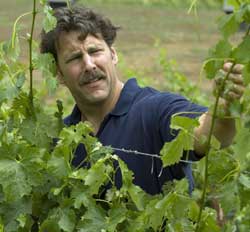
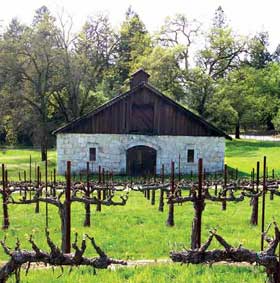
 READER FEEDBACK: To post your comments on this story,
READER FEEDBACK: To post your comments on this story,




